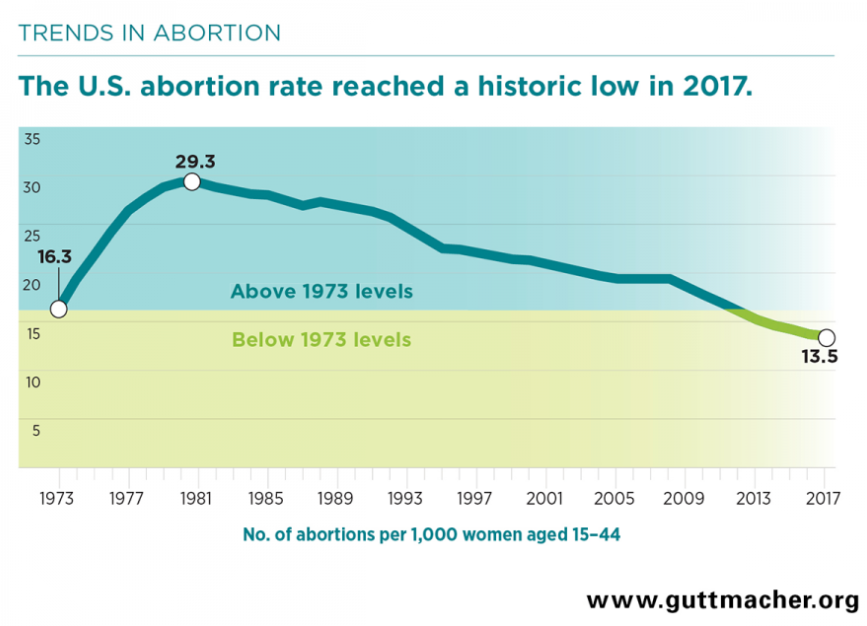Abortion Rates Fall To Lowest Level Since Procedure Was Legalized In 1973
A new study released on Wednesday by the Guttmacher institute shows that abortion rates have fallen to their lowest level since the procedure was legalized in 1973, according to the BBC.
The study shows that abortion rates declined 7% from 2014 to 2017 and that, in 2017, 862,320 abortions were performed. This is lower than 2011 by about 200,000 abortions and down from a high of 1.6 million in 1990.
The institute says that the lower number isn’t necessarily a result of new laws or conservative politicians trying to restrict access. Rather, it offers several different theories as to why the rate could be plummeting.
First, it suggests that better reproductive healthcare could be part of the reason. The authors of the report found that better access to contraception and improvement in female contraception, like IUDs and implants, may have contributed to the decline. These forms of contraception are now covered by insurance companies due to the 2009 Affordable Care Act.
Elizabeth Nash, a policy manager for the Guttmacher Institute said that the report shows the national average. She pointed out that even though the average distance traveled for an abortion was 34 miles, some women were forced to travel much further.
“Some people are going hundreds of miles while some people are living in cities where they can take the bus or the train,” she said.
Second, the report suggests that at-home abortions could be contributing to the rate falling. Despite 95% of all procedures taking place in clinics, use of the abortion pill accounted for 39% of abortions in 2017, up from 20% in 2014. These abortions are harder to track.
Increased legal restrictions may also be part of the reason the rate is dropping. Between 2011 and 2017, 32 states enacted a total of 394 new restrictions on abortions. Some of the “harshest restrictions to date” have been passed by conservative leaning states in 2018, even though some have been blocked by courts temporarily.
Anti-abortion advocates believe that the legal restrictions are helping slow the abortion rate.
Laura Echevarria of the anti-abortion National Right to Life Committee said: “I think they are having an impact. If it’s not having a huge impact then why is everyone in the abortion industry up in arms every time a law is passed?”
Nash thinks that even though increased restrictions “play a role” that “the numbers don’t tell the whole story”.
She continued: “The abortion rate, whether it declines or increases, is not really the indicator of access. What we need to do is think about what abortion services look like for each individual and whether or not they’re affordable and available.”
Some states that passed harsher abortion laws between 2014 and 2017 actually saw increases in abortion rates. Several states that opened new clinics saw abortion rates move lower. Overall, the US saw a net gain of clinics between 2014 and 2017.
Lower birthrates are also likely helping the abortion trend. In general, women are choosing to have fewer children. With the US birthrate at its lowest level since 1987, the number of births per thousand – and fertility – both fell to their lowest levels since 1987.
The decrease in births is being attributed to women seeking higher education and employment, as well as changing societal expectations and limited provision for parental leave from work.
Finally, some believe the decline in abortion rates is a result of anti-abortion advocates having more of an impact.
National Right to Life Committee President Carol Tobias said: “The pro-life movement’s efforts to educate American’s about the humanity of the unborn child and pass protective pro-life legislation are having an impact.”
NRLC Laura Echevarria spokeswoman concluded: “Knowledge of what happens inside the womb has become mainstream.”
Tyler Durden
Tue, 09/24/2019 – 23:25
![]()
Zero Hedge’s mission is to widen the scope of financial, economic and political information available to the professional investing public, to skeptically examine and, where necessary, attack the flaccid institution that financial journalism has become, to liberate oppressed knowledge, to provide analysis uninhibited by political constraint and to facilitate information’s unending quest for freedom. Visit https://www.zerohedge.com


